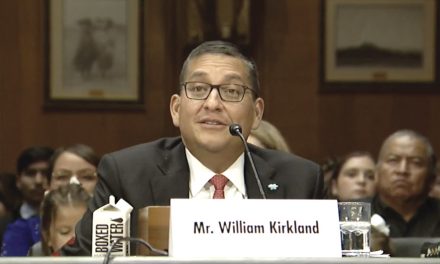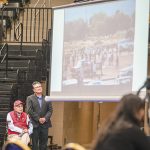
50 Years Ago: Nakai, MacDonald debate at Blue Gap
The Navajo Nation primary will be held Monday and pretty much everyone believes Raymond Nakai and Peter MacDonald will take the two top spots. These are the two that spent the most money, had the biggest rallies and who put up the most billable hours on local radio stations.
That last item was the most important because the majority of those who would be going to the polls next week were most influenced by what they learned about the candidates during their radio speeches.
Nakai appeared to be aiming most of his political ads at members of the Navajoland Native American Church and Navajo ranchers. MacDonald seemed to be going heavily on messages to those who wanted more job opportunities on the reservation.
Unlike modern elections, where candidate debates are held numerous times during the campaigns, no effort seems to have been made to have the two debate each other, which made what happened in Blue Gap a few days before the primary so interesting.
It wasn’t billed as a debate as such but it sort of became one before it was over. The two top candidates agreed to appear and speak to chapter members at the same meeting. Both the Navajo Times and the Gallup Independent decided to cover the event. Both reporters were non-Navajo and since the meeting was almost entirely in Diné bizaad, it’s questionable just how much they understood about what was said.
The format was simple. Nakai would go first and give a speech and then answer questions from the audience. MacDonald would then be given the stage and he would speak and answer questions. There were no plans for the candidates to interact. To say the meeting was long would be an understatement. Nakai began speaking at 2:30 p.m. and turned over the stage to MacDonald at 7 p.m.
MacDonald then spoke until 9:30 p.m. (Nakai probably didn’t speak the whole five hours. They probably took a break for dinner.) As far as can be determined from the news stories that later appeared in print, the candidates stuck to the issues, which centered on the land dispute with the Hopis, economic development and exploiting the tribe’s mineral resources to create more jobs and raise revenue to grow the tribal government and provide scholarships to Navajo college students.
The meeting became a debate when MacDonald began criticizing Nakai’s approach to economic development by bringing in companies like Fed Mart and General Dynamics.
This kind of economic development was bad, he said, because it created a situation where the Navajo people were dependent on someone other than their own people for survival. Nakai had decided to stick around to hear what MacDonald said and he stood up and defended his actions, pointing out that Navajo families benefited from the low prices at Fed Mart. He said the Navajo people still didn’t have enough expertise or talent to run their own businesses. MacDonald disagreed, saying Navajos have spent enough time working for non-Navajos and were ready to run their own businesses or manage company operations.
MacDonald seemed to have the best ideas but it was questionable that many in the audience could see this after listening to several hours of speeches, according to Dick Hardwick, the managing editor for the Times and the person who covered the meeting for the paper.
Two days after the Navajo primary, the Gallup Inter-Tribal Indian Ceremonial was scheduled to begin and news stories about the 1970 show centered on possible protests and not what kinds of events would take place. There was no doubt that demonstrations would take place, but no one knew just what form they would take and how much they would disrupt the events.
The previous year, the association forced four Navajos who had been passing out anti-Ceremonial leaflets to leave the grounds and this action had been upheld in court.
This year the association decided to get ahead of the problem and issue permits to anyone who wanted to hold a protest during the Ceremonial. A week before the event, six people representing four groups had applied for the permits.
Ike Merry, executive director of the event, said the permits would be issued out the day before the Ceremonial began because the committee overseeing that aspect of the event was trying to draw up guidelines that the groups would have to follow. The new guidelines were expected to prohibit any kind of demonstration on Ceremonial grounds.
Groups would be allowed to hold their protest at the entrance to the grounds – if they did not block anyone from entering. The one thing Ceremonial officials seemed to fear the most was a sit-in before the evening dances. Sit-ins had become an effective method of protest by Black groups and the thought of a dozen young Navajos handcuffed together in front of the entrance to the dances worried event organizers.
Association members also expected some kind of protest during the annual parade downtown but this was out of their control. They did take steps to lower the possibility of members of the dance groups joining the protests. About $35,000 was spent improving the housing quarters provided to the dance groups and their pay was increased. The association also planned to hold a meeting with the dance groups the day before the Ceremonial began to hear any complaints the dance groups had.
More security was added and local law enforcement agencies agreed to be on the outlook for any kind of disturbance. Navajo Nation police also agreed to send a couple of more officers to help provide security. “We’re doing all we can to put on the best show we can,” said Merry, who added that this was the most nerve-racking event he has worked on. “We just have to wait to see what happens.”








 Highway 264,
Highway 264, I-40, WB @ Winslow
I-40, WB @ Winslow